Speech Financial Developments

Ric Battellino
[*]
Deputy Governor
Address to Property Council of Australia, Queensland Division, Downtown Luncheon
Brisbane –
Introduction
The Reserve Bank has put out a considerable amount of material on the economy in recent weeks, so today I will keep my comments on economic developments relatively short. Rather, I will spend most of my time today talking about finance.
As you know, there are concerns at present about the availability of finance, particularly for the property sector, so I think it is worth spending some time examining what is going on.
Recent Economic Developments
Before I talk about financing, however, let me set the scene with a few brief words on the economy.
The global economy started to recover about a year ago from what was a very severe recession. That recovery is continuing, but the pace of growth differs significantly across the various regions of the world (Graph 1).
Asian growth had been exceptionally strong late in 2009 and earlier this year and central banks in the region have begun to tighten monetary policy settings. Many commentators worry that the tightening might result in excessive slowing in these economies, but our reading of recent data suggests that growth is returning to around a trend rate.
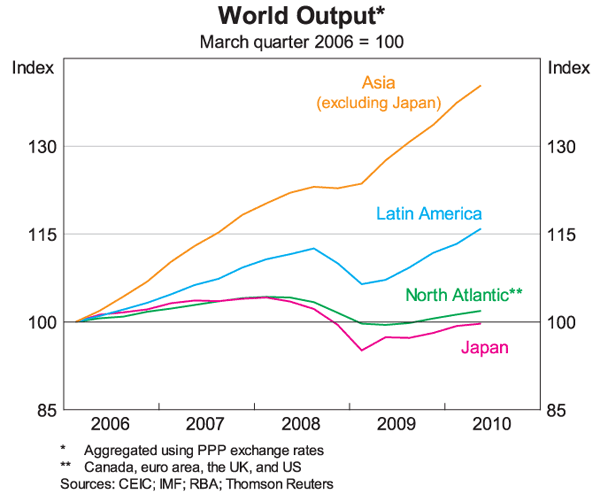
Latin America is also generally performing well.
Growth in the US economy, however, has been lacklustre. It is continuing to grow, but momentum has clearly slowed. While recent data have been a bit better than over the previous couple of months, risks still look tilted to the downside. Consumer confidence remains low, the housing and labour markets remain weak, and the repair of household balance sheets still has quite a way to run. One bright spot in the United States is that business balance sheets are in good shape and equipment investment is recovering.
In Europe, there is a large disparity in growth across countries. Germany remains the clear front-runner, benefiting from earlier economic reforms and Chinese demand for German capital goods. German unemployment has fallen to its lowest rate since the early 1990s. Other large countries such as France and Italy are growing but probably still below trend, while some small countries, such as Greece and Ireland, are still experiencing very deep recessions.
Overall, recent data have been consistent with around trend growth in the global economy. Our central scenario is for growth to continue at around this pace over the next year or so. This view is broadly similar to that of the IMF and other forecasters (Graph 2).

From Australia's perspective, this would represent a favourable outcome, resulting in commodity prices remaining at relatively high levels compared with earlier decades, even if, as we forecast, they decline somewhat from their current elevated levels.
In the Australian economy, growth is around trend and underlying inflation is in the target range. This is a comfortable position to be in, but the challenge is to keep the economy there over the next few years. The challenge will not be easy. First, the economy has been growing continuously for almost 20 years, having experienced only relatively mild downturns during that period, and is therefore approaching full capacity; and second, the resources boom that began about 2005, and which abated for a time during the global financial crisis, is re-emerging, adding to the pressure on capacity.
Over the next couple of years, we expect economic growth in Australia to pick up from its current rate of 3¼ per cent, to closer to 4 per cent. Domestic spending is expected to drive this pick-up. Over the past year, final demand grew by about 5 per cent, partly due to government spending (Graph 3). This is in the process of being scaled back, but indications are that private spending will pick up noticeably in the period ahead. This is especially the case for business investment. Income growth will add to spending capacity; over the past year, reflecting the rise in the terms of trade, nominal GDP in Australia rose by 10 per cent.
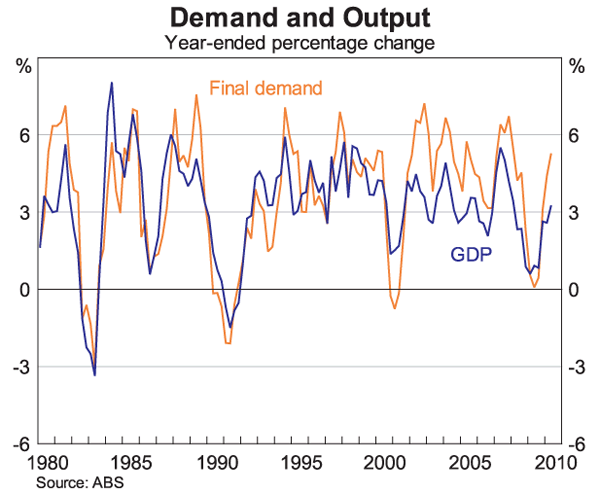
If, as expected, growth in Australia increases to an above-trend pace, it is likely that in due course underlying inflation will pick up from its current level of 2¾ per cent. We are currently forecasting it to rise to around 3 per cent by the first half of 2012 (Graph 4).
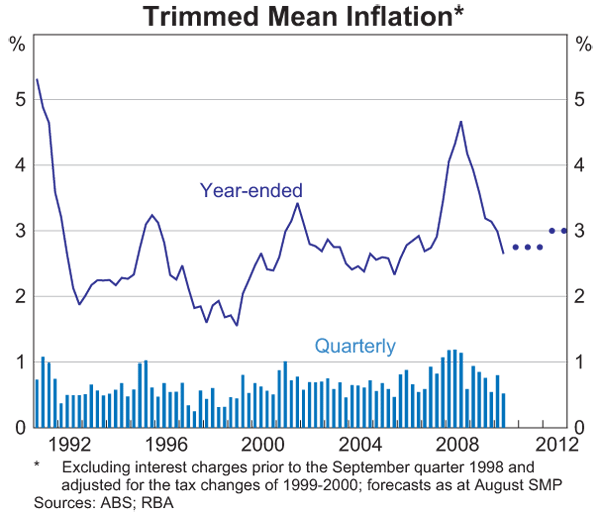
As you know, earlier this year the Reserve Bank Board returned official interest rates to a level that is consistent with lending interest rates being close to their average levels. Having done so, we have been comfortable to leave official interest rates unchanged in recent months. However, as noted in the statement issued after the Board meeting earlier this week, if economic conditions evolve as currently expected, it will be likely that higher interest rates will be required at some point to ensure that inflation remains consistent with the medium-term target.
Overall Financing Activity
I will turn now to financing activity.
Since the global financial crisis, the availability of credit has tightened significantly around the globe. The rate of growth of credit in most advanced economies is currently close to zero, or even negative (Graph 5).

Australia has not been immune from these developments, though credit growth has held up better here than in other countries.
We should not be surprised that credit growth has slowed, as this is typically what happens after a financial crisis.
In the boom years that precede a crisis, credit expands very strongly as businesses or households (or both) gear up, either to fund spending or asset acquisition. Some of the decisions that people make during those periods are based on unrealistic expectations about future economic conditions or asset prices. As such, they turn out not to be financially viable.
A process of de-leveraging therefore follows. Businesses and households become more cautious, increasing saving, selling assets and reducing debt. Lenders also become more cautious, both because they see the weaker economic circumstances as increasing the risk on loans, particularly as collateral values decline, and because they typically begin to experience a noticeable increase in bad loans. The result is that both the demand for, and the supply of, credit tend to decline.
The authorities typically take steps to counter these forces, through tightening in the upswing and then easier economic policies in the downswing, and sometimes through direct fiscal assistance to lenders to help them sustain the supply of credit.
However, it would be unrealistic to expect that these measures can entirely smooth out the credit cycle, just as it would be unrealistic to expect that the authorities can eliminate the cycle in equity markets. These cycles are inherent in human behaviour. History shows that it takes time for households, businesses and lenders to regain confidence after a financial crisis, and there are limits on the extent to which economic policy measures can accelerate the process.
This is a very significant issue in many developed countries at present. Here in Australia, the credit cycle was mild compared with overseas experience, but nonetheless there was a cycle. Credit, particularly to businesses, increased relatively quickly for a number of years, and now the downside of that cycle is currently being played out.
In the period since the mid 1980s, there have been three broad expansion phases in credit in Australia: two related to business credit and one to household credit. The first of the cycles in business credit began in the mid 1980s when financial deregulation led to a strong expansion in credit to businesses. The annual growth in business credit exceeded 30 per cent for a time. The subsequent economic downturn saw many business failures, large losses by the banks and a prolonged period of deleveraging by business (Graph 6).
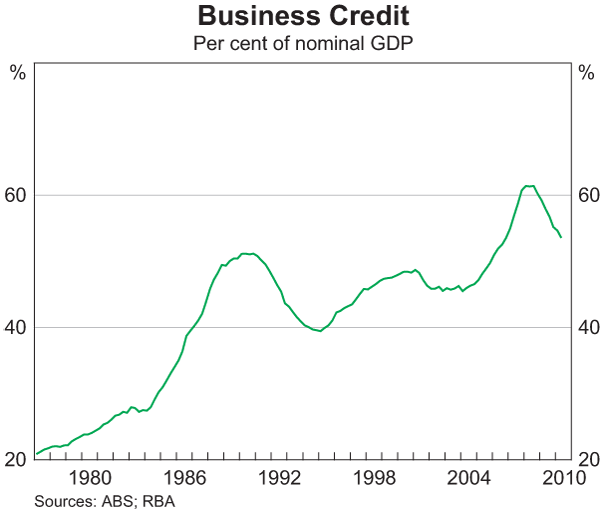
Following that episode, it took almost four years for credit growth to return to a relatively normal rate.
The next phase of credit growth was driven by the household sector. This began in the mid 1990s. Up until then, Australian households had relatively little debt by international standards, with debt outstanding equal to about 50 per cent of household disposable income. The fall in interest rates in the early 1990s, the switch in financial innovation from products directed to businesses to those directed to households and the general prosperity of the economy saw households substantially increase their debt over the subsequent 10–15 years, to about 1½ times income (Graph 7). This ratio is broadly in line with debt levels of households in other developed economies.
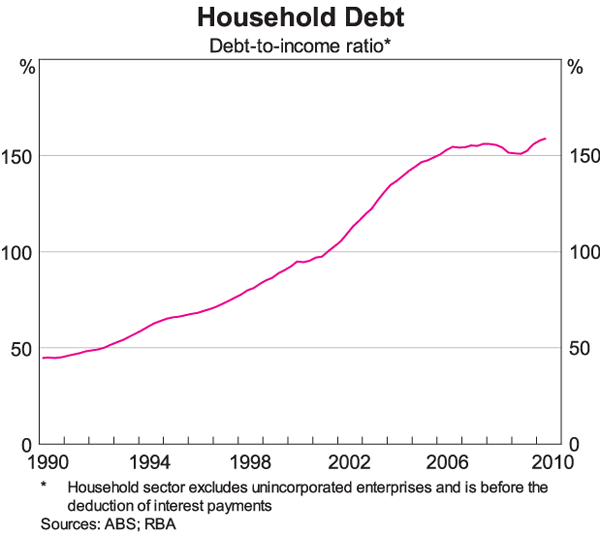
Most of this increase in debt was for the purchase of housing, and was mirrored in a corresponding rise in house prices.
Since about 2005, the pace of growth of household credit has slowed, and on average has been broadly equal to the rate of growth of household income. As the Bank has noted before, this is a reassuring development since continued increases in the gearing of the household sector would eventually have exposed the sector to substantial risk.
Growth in household credit continues to be moderate. Over the past year or so, household credit has increased by around 7 per cent. Most of this has been due to housing loans, while other forms of household debt, such as credit card debt, margin loans and personal loans have been relatively flat.
All this is consistent with households taking a more cautious approach to their finances, as evidenced also by the increase in the household saving rate relative to that seen in the early and middle parts of the past decade.
For households, therefore, the current picture is one where borrowing for housing is broadly growing in line with income, house prices are stable and there is little appetite for other forms of debt. From the Reserve Bank's perspective, this seems to be a satisfactory state of affairs.
The third episode I want to talk about is the pick-up in business credit that began in 2005. This cycle was not as pronounced as that in the 1980s but, nonetheless, for a time business credit grew by about 20 per cent per year.
Part of this debt was to fund investment which, as you know, has been very strong, but a significant part was also for financial activity. There was a general increase in gearing in the corporate sector, as boards worried that they could be seen as having lazy balance sheets, making them takeover targets for private equity. Over the four years to 2008, the gearing ratio of the corporate sector rose from around 60 per cent to over 80 per cent (Graph 8).
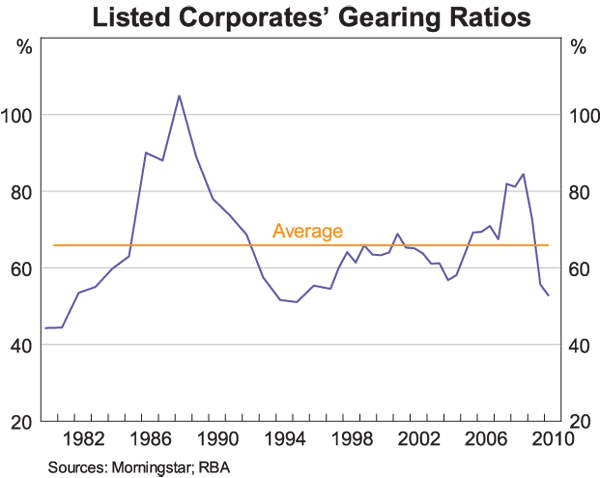
The global financial crisis brought a change in thinking by both businesses and their lenders, and there has been a sharp slowing in business credit. Over the past year, business credit has fallen by about 4 per cent.
This has not translated to a sharp weakening in economic activity, as was the case in the early 1990s, because a shift is taking place in the way businesses are funding themselves. Helped by the pool of funds that has been built up through the superannuation system, businesses were able to raise substantial amounts of equity when debt markets dried up during the financial crisis. Most importantly, however, internally generated funding from profits has also been very strong. As such, the total availability of funds to businesses has continued to increase at around its long-run average rate (Graph 9).
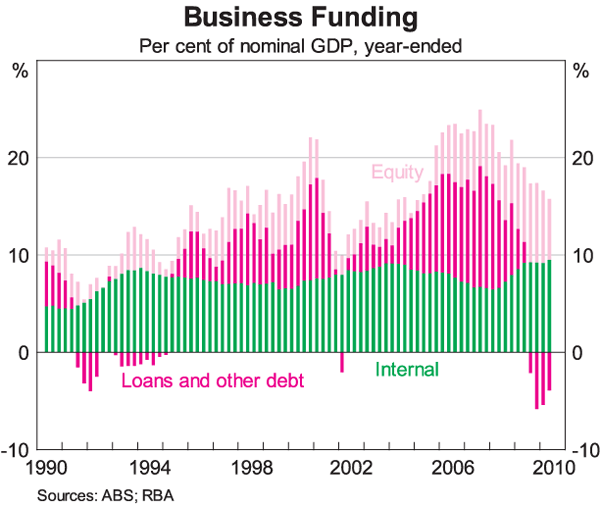
These shifts in funding patterns mean that movements in credit, by themselves, may not give an accurate picture of the overall availability of funds to businesses.
The trends that we have observed recently are not evenly spread through the business sector. The mining sector has made heavy use of internal funds while the property and infrastructure sectors have relied much more on debt. I will say more about these sectoral issues later.
While the small business sector is often the focus when people worry about the availability of credit, the recent cycle in credit to small business has not been as severe as that in credit to large business (Graph 10). Growth in credit to the small business sector through the boom years was more restrained than the run-up in credit to the large business sector, and credit outstanding has held up better since. Over the past six months or so, credit to small business has grown at an annual rate of about 8 per cent.
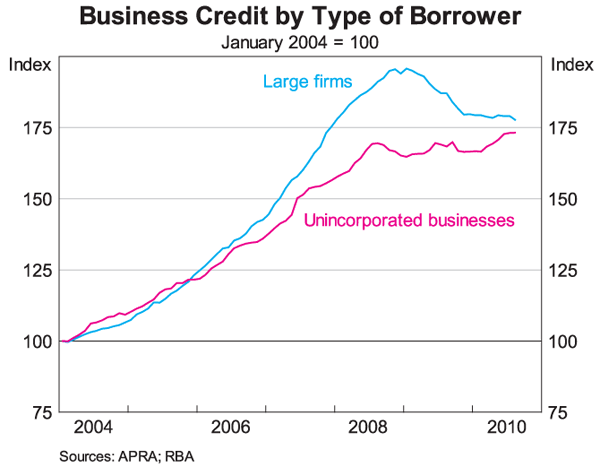
Property Financing
Given the obvious interests of this group, let me end by looking in more detail at property financing.
Property-related lending accounts for a very significant share of the business lending undertaken by banks and other lenders. It also tends to be among the most cyclical components of lending, rising strongly during boom periods and then contracting sharply. It is also a component of lending on which defaults can rise quickly.
The Reserve Bank monitors lending to the property sector very closely, because it has important implications for both the performance of the economy and the stability of the financial system.
Lending to the commercial property sector began to pick up noticeably from around 2004 onwards, and at its peak just before the global financial crisis was growing by 27 per cent per year (Graph 11). Foreign-owned banks were the lenders with the fastest growth through this period (Graph 12).
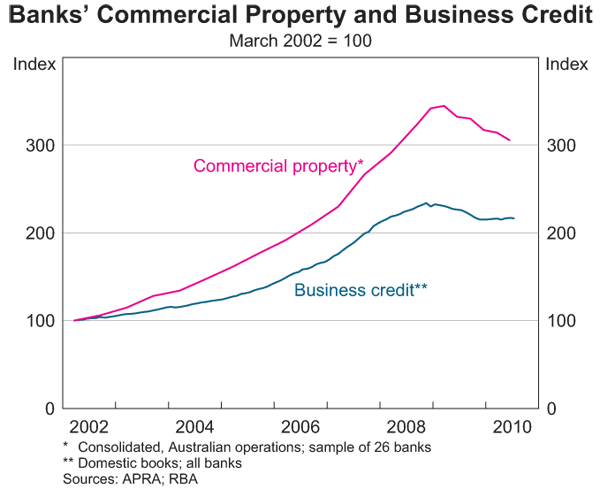
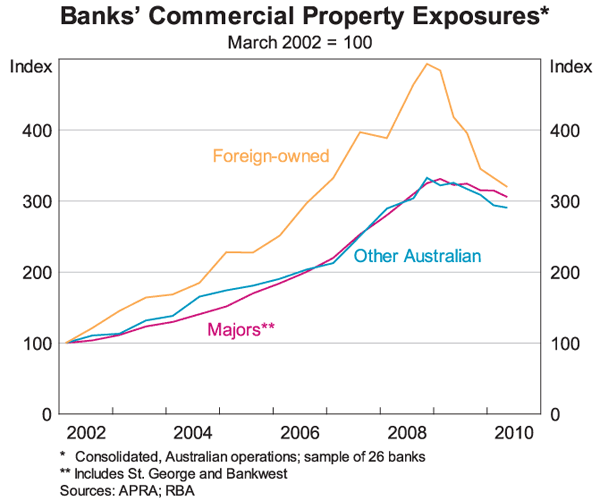
With lending for commercial property growing significantly faster than other business lending, its share of total business lending increased from about one-quarter to around one-third. For the regional banks and foreign-owned banks, the ratio was considerably higher, in some cases close to half.
Given this rise in the proportion of lending going to the property sector, it is perhaps not surprising that many banks now feel they are overweight to that sector and are reluctant to make new loans, while some are seeking to cut back.
Since the peak in early 2009, commercial property lending has decreased by about 10 per cent. Foreign banks have led the contraction, reducing their exposures by a cumulative 35 per cent since the peak. Loan limits have fallen more than outstandings, so that usage of lending facilities has increased to about 90 per cent.
At the same time, funding through non-bank sources has also tightened. Commercial mortgage-backed securities, which at the peak in 2007 accounted for around 5 per cent of total commercial property funding, have contracted by about two-thirds since then. The contraction in mortgage trusts and some other funds, entities that were substantial investors in these securities, helped to drive the decline.
Adding to the cyclicality in commercial property lending is the fact that these loans have tended to be among the most risky of bank loans. That was the case in the early 1990s and it has again been the case recently.
The proportion of commercial property loans that are impaired has risen sharply since 2007, from less than 0.5 per cent to around 6 per cent. This is much higher than the impairment rate for business loans in general, which has only risen to around 3 per cent (Graph 13). The impairment rate has risen particularly sharply for loans to the retail and residential segments of the commercial property sector.
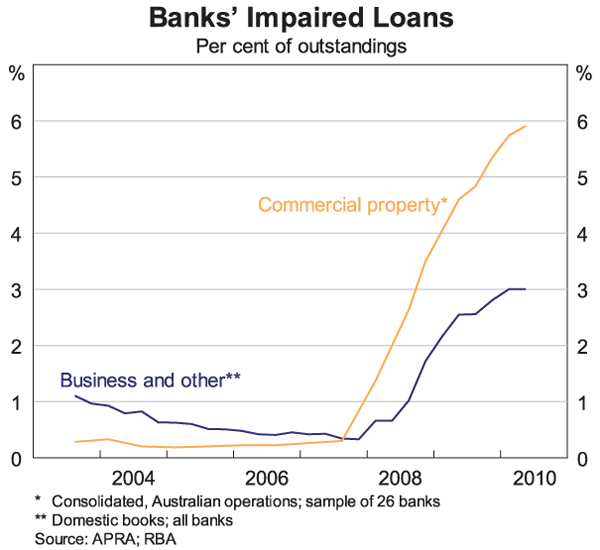
The banks that expanded their lending the fastest through the boom have since experienced the sharpest increase in impaired loans. For foreign-owned banks, about 15 per cent of commercial property loans are impaired, compared with around 4 per cent for the major Australian banks (Graph 14).
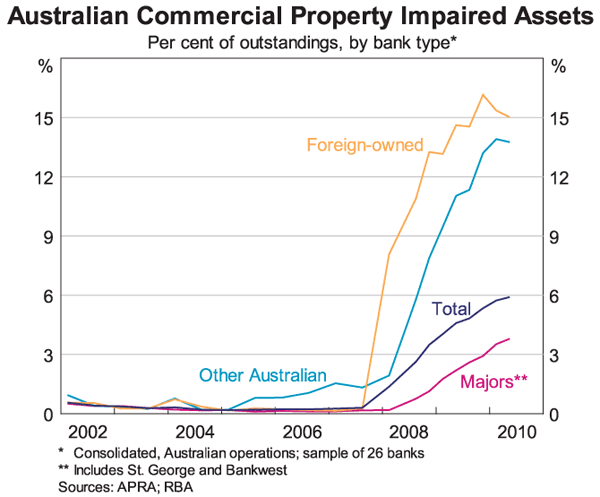
The property sector is vulnerable to changes in the availability of credit because it operates with a relatively high level of gearing and low holdings of cash. Gearing of listed real estate companies has risen substantially over the past decade. It used to be the case that the sector had substantially lower gearing than the corporate sector in general, but the run-up in debt, followed by the fall in asset values, resulted in gearing of the sector reaching a peak of over 100 per cent by late 2008, well above the corporate sector average (Graph 15).
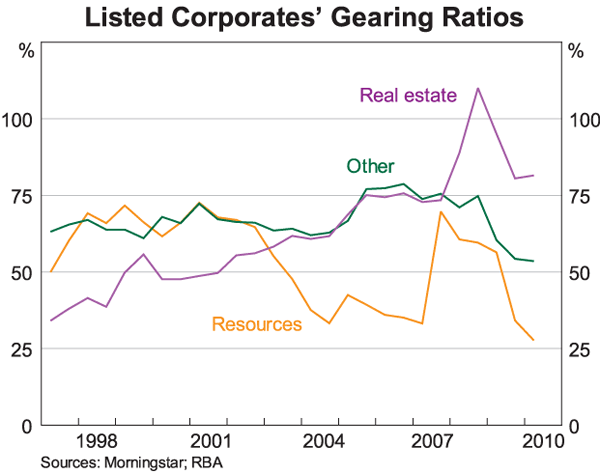
Similarly, cash holdings of corporations in the real estate sector are low compared with other corporates (Graph 16). Through the boom years, cash holdings of listed real estate companies fell to less than 2 per cent of assets, compared with 6–8 per cent elsewhere in the corporate sector.
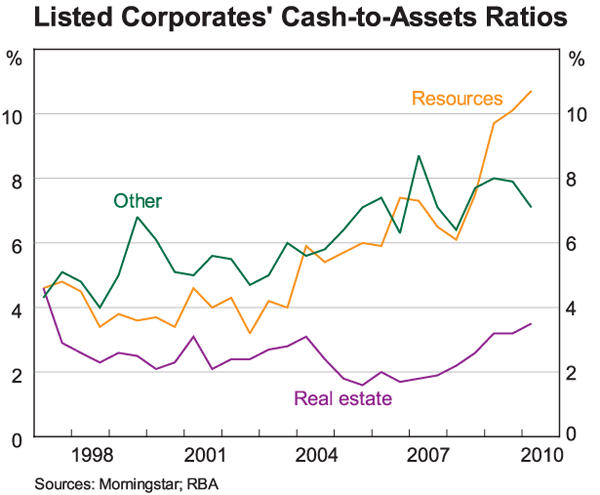
In short, it is difficult not to conclude that the financing of the property sector became over-extended during the boom years, and that a period of adjustment was largely unavoidable. In saying this, I don't want to downplay the difficulties that some firms are now experiencing as that adjustment takes place, or the impact it is having on property development. The Reserve Bank is very much aware of both these issues. But cycles like the one we are going through seem to be endemic to the property sector and raise the question of whether, over the longer term, the financing model of the sector should shift towards more equity and less debt.
Conclusion
Let me end, however, on a more positive note by making the observation that the adjustment process has been underway for some time now and substantial progress has been made. The equity raisings that have taken place have made an important contribution to reducing gearing levels, and the run-up in arrears on property loans may be coming to an end. More generally, the expected improvement in the economy over the next couple of years will be reflected in the commercial property market also. I think there are already some signs of this. That in turn should boost lenders' willingness to make loans to the sector, though I don't think it would be in anybody's interest to return to the free-flowing credit of a few years ago.
Endnote
I would like to thank Patrick D'Arcy of the Bank's Domestic Markets Department for his assistance in preparing this talk. [*]